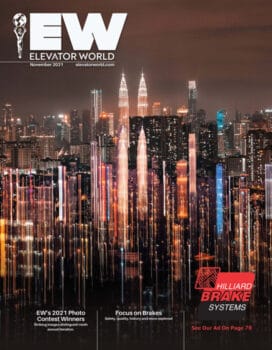The Future of Tall Buildings
Nov 1, 2021

I read recently that more high-rise buildings have been built in the past 20 years than existed before. That’s following 9/11, when everyone was afraid no one would want to work in a high-rise again! The tallest building in the world, the Burj Khalifa, was built just three years after 9/11. In the past 20 years, supertall buildings have been hardened and reconfigured for faster, safer exits, and building design concepts and codes have been forever altered. There has been intense collaboration among engineers, architects, fire/life-safety experts and elevator contractors to ensure that elevators remain operational during disasters. In addition to adjusting codes to allow for wider, smoke-resistant stairs, elevators are now increasingly equipped with battery systems, generator backup power and water-resistant components to protect equipment from fire-sprinkler damage. Many elevator lobbies now have raised sills to keep water from entering shafts. Development of occupant evacuation operation (OEO) elevators has increased the ability to evacuate buildings and fight fires.
What do the next 20 years hold for tall buildings? Will we work in them, shop in them and live in them? Certainly, we will, and possibly, all in the same building. The trend toward mixed-use buildings is increasing. Architect James von Klemperer of Kohn Pedersen Fox said mixed-use skyscrapers can help ensure those buildings become better assets for the community. The pandemic and climate change will also have the biggest influence on the designs of the future. Many countries have a goal of being carbon-neutral by 2050, so the next 20 years will be very important. Ventilation in high rises will have to be addressed, perhaps with operational windows or other ventilation options. The sealed-envelope building will disappear, as it is very expensive to cool and heat. Dan Winey, CEO of Gensler, said he thinks 20 years will see curtain walls on buildings that generate their own electricity through solar power. Timber may also be used in more buildings. Many architects see skyscrapers becoming more human-centric. Some believe that 30% of “days in the office” will change forever. Therefore, offices may become more flexible. More people will work from home, and robots may take over many of the low-level rote jobs.
What does this mean for the elevator industry? Maybe not much in the short-term. But, long-term, we will grow and innovate along with the architects and developers. It is already happening. I hear whispers of robot installations, drone inspections and solar-powered elevators. I can’t wait to see what happens.
In the meantime, we celebrate vertical transportation (VT) in Dazzling, Colorful, Diverse: EW’s 2021 Photo Contest Winners by Kaija Wilkinson. Every year, we are indeed dazzled by the beauty of our industry and its equipment. Out in the field, our winning photographers give a unique viewpoint, and we are happy to publish it in our pages.
Another feature with an artistic flair is Soaring Views by Lindsay Fletcher. Toshiba Elevator Middle East provided the VT for the towers of Harbour Views, the tallest twin towers on Creek Island in Dubai.
Our focus this month is on Brakes, a subject we rarely address. The articles we received are excellent. They are:
- Unitized vs. Caliper vs. Drum by Brian Mather. The author describes the differences and similarities of three types of electromagnetic brakes.
- Elevator Safety Requires Quality submitted by mayr. In this Readers’ Platform, the author argues that just being able to manufacture brakes is not enough. Elevator contractors must choose reliability and experience to avoid surprises.
- Elevator Brakes 1895–1927 by Dr. Lee Gray. Our historian goes back to Annett’s book with discussions about post-modern brakes. Then he brings us forward into the 20th century.
Finally, we have an exciting feature, Vision Realized, by Wilkinson. Earlier this month, EW traveled to the opening of the brand-new National Training Center unveiled by the National Elevator Industry Education Program and International Union of Elevator Constructors officials. In Warwick, Rhode Island, the 98,000-ft2 facility is state of the art. As training becomes more important than ever for our industry, I am reminded that “a rising tide lifts all boats.”
Get more of Elevator World. Sign up for our free e-newsletter.









